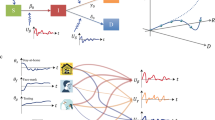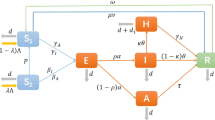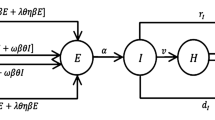Abstract
The main objective of this article is to study the effectiveness of wearing masks and implementing active screening and testing to contain the spread of COVID-19 during stages when the disease has already started to spread. This work innovates by focusing on the basic measures of mask use and active screening and testing, which are frequently overlooked in the literature in favor of more expensive interventions like travel bans and vaccinations. We study their effectiveness and determine the optimal way to implement them. To achieve this goal, we develop a stochastic SEIR model that includes four populations: susceptible, exposed, infected, and recovered individuals. We integrate two control functions into the model to represent mask-wearing and active screening and testing interventions. Using an adapted formulation of Pontryagin’s maximum principle suitable for the stochastic context, we aim to find the optimal approach to implementing these controls. We combine the Forward-Backward Sweep Method (FBSM) with a special Runge–Kutta scheme for stochastic differential equations to solve the optimality system for our stochastic optimal control problem. Our study demonstrates that even when the disease has begun to spread, using both mask-wearing and active screening and testing can lead to significant reductions in the numbers of exposed and infected individuals, offering a cost-effective strategy for countries with limited resources.







Similar content being viewed by others
References
Russell, J.Z., Cheryl, B.: COVID-19 generation: a conceptual framework of the consumer behavioral shifts to be caused by the COVID-19 pandemic. J. Int. Consum. Mark. 33, 58–67 (2021)
Gossling, S., Scott, D., Hall, C.M.: Pandemics, tourism and global change: a rapid assessment of COVID-19. J. Sustain. Tour. 29, 1–20 (2021)
Altig, D., et al.: Economic uncertainty before and during the COVID-19 pandemic. J. Public Econ. 191, 104274 (2020)
Eric, R., Angelina, R.S., Michael, D., Andrew, J.A.: Systematic review and meta-analysis of longitudinal cohort studies comparing mental health before versus during the COVID-19 pandemic in 2020. J. Affect. Disord. 296, 567–576 (2022)
Kermack, W.O., McKendrick, A.G.: Contributions to the mathematical theory of epidemics part 1. Proc. Royal Soc. London Series A Math. Phys. Sci. 115, 700–721 (1927)
Wenjun, M., Shadi, M., Sandro, Z., Francesco, B.: On the dynamics of deterministic epidemic propagation over networks. Annu. Rev. Control. 44, 116–128 (2017)
Kumar, A., Goel, K., Nilam, A.: Deterministic time-delayed SIR epidemic model: mathematical modeling and analysis. Theory Biosci. 139, 67–76 (2020)
Laaroussi, A.E., El Bhih, A., Rachik, M.: Optimal vaccination and treatment policies with constrained inequalities to study limited vaccination resources for a multistrain reaction-diffusion SEIR model of COVID-19. Partial Differ. Equ. Appl. Math. 10, 100684 (2024)
El Bhih, A., Yaagoub, Z., Rachik, M., et al.: Controlling the dissemination of rumors and antirumors in social networks: a mathematical modeling and analysis approach. Eur. Phys. J. Plus. 139, 118 (2024)
Zouhri, S., El Baroudi, M.: Mathematical formalism for agent-based model of proteins interaction inside cancer cell. Communications in Mathematical Biology and Neuroscience. 2023 (2023)
Angstmann, C.N., Henry, B.I., McGann, A.V.: A fractional order recovery SIR model from a stochastic process. Bull. Math. Biol. 78, 468–499 (2016)
Hattaf, K., Mahrouf, M., Adnani, J., Yousfi, N.: Qualitative analysis of a stochastic epidemic model with specific functional response and temporary immunity. Physica A 490, 591–600 (2018)
Linda, J.S.A.: A primer on stochastic epidemic models: formulation, numerical simulation, and analysis. Infect. Dis. Modell. 2, 128–142 (2017)
Elqaddaoui, A., El Bhih, A., Laarabi, H., Rachik, M., Abta, A.: A stochastic optimal control strategy for multi-strain COVID-19 spread. Communications in Mathematical Biology and Neuroscience. 2023 (2023)
Zouhri, S., Saadi, S., Rachik, M.: Simulation of tumor response to immunotherapy using a hybrid cellular automata model. Int. J. Appl. Comput. Math. 3, 1077–1101 (2017)
Wei, Z., Li, Y., Kapitaniak, T., Zhang, W.: Analysis of chaos and capsizing of a class of nonlinear ship rolling systems under excitation of random waves. Chaos. 34, 043106 (2024)
Wei, Z., Li, Y., Moroz, I., Zhang, W.: Melnikov-type method for a class of planar hybrid piecewise-smooth systems with impulsive effect and noise excitation: Heteroclinic orbits. Chaos. 32, 103127 (2022)
Li, Y., Wei, Z.: Dynamics and optimal control of a stochastic coronavirus (COVID-19) epidemic model with diffusion. Nonlinear Dyn. 109, 91–120 (2022)
Zouhri, S., El Baroudi, M., Saadi, S.: Optimal control with isoperimetric constraint for chemotherapy of tumors. Int. J. Appl. Comput. Math. 8, 215 (2022)
Zouhri, S., El Baroudi, M.: Free end-time optimal control problem for cancer chemotherapy. Differential Equations and Dynamical Systems. (2023)
Zouhri, S., Saadi, S., Elmouki, I., Hamdache, A., Rachik, M.: Mixed immunotherapy and chemotherapy of tumors: optimal control approach. Int. J. Comput. Sci. Issues. 10, 81 (2013)
Roshanfekr, M., Farahi, M.H., Rahbarian, R.A.: Different approach of optimal control on an HIV immunology model. Ain Shams Eng. J. 5, 213–219 (2014)
Zhou, Y., Liang, Y., Wu, J.: An optimal strategy for HIV multitherapy. J. Comput. Appl. Math. 263, 326–337 (2014)
Ding, C., Tao, N., Zhu, Y.: A mathematical model of Zika virus and its optimal control. 35th Chinese Control Conference (CCC), Chengdu, China. 2642-2645 (2016)
Kim, B.N., Nah, K., Chu, C., Ryu, S.U., Kang, Y.H., Kim, Y.: Optimal Control Strategy of Plasmodium vivax Malaria Transmission in Korea. Osong Public Health Res. Perspect. 3, 128–136 (2012)
Prosper, O., Ruktanonchai, N., Martcheva, M.: Optimal vaccination and bednet maintenance for the control of malaria in a region with naturally acquired immunity. J. Theor. Biol. 353, 142–156 (2014)
Jung, E., Lenhart, S., Feng, Z.: Optimal control of treatments in a two-strain tuberculosis model. Dis. Contin. Dyn. Syst. B. 2, 473–482 (2002)
Moualeu, D.P., Weiser, M., Ehrig, R., Deuflhard, P.: Optimal control for a tuberculosis model with undetected cases in Cameroon. Commun. Nonlinear Sci. Numer. Simul. 20, 986–1003 (2015)
Rawson, T., Brewer, T., Veltcheva, D., Huntingford, C., Bonsall, M.B.: How and when to end the COVID-19 lockdown: an optimization approach. Front. Public Health. 8, 262 (2020)
Matralt, L., Eaton, J., Leung, T., Brown, E.R.: Vaccine optimization for COVID-19: Who to vaccinate first. Sci. Adv. 7, eabf1374 (2021)
Rachah, A., Torres, D.F.M.: Mathematical modelling, simulation, and optimal control of the 2014 Ebola outbreak in West Africa. Dis. Dyn. Nat. Soc. 9, 842792 (2015)
Jung, E., Iwami, S., Takeuchi, Y., Jo, T.C.: Optimal control strategy for prevention of avian influenza pandemic. J. Theor. Biol. 260, 220–229 (2009)
Su, Y., Sun, D.: Optimal control of anti-HBV treatment based on combination of traditional Chinese medicine and Western medicine. Biomed. Signal Process. Control 15, 41–48 (2015)
Lowden, J., Miller, N.R., Yahdi, M.: Optimal control of vancomycin-resistant enterococci using preventive care and treatment of infections. Math. Biosci. 249, 8–17 (2014)
Okuonghae, D., Omame, A.: Analysis of a mathematical model for COVID-19 population dynamics in Lagos Nigeria. Chaos Solitons and Fractals. 139, 110032 (2020)
Kaitlyn, M., Peter, A.M.: Mathematical modelling of the spread of COVID-19 on a university campus. Infect. Dis. Modell. 6, 1025–1045 (2021)
Stutt Richard, O.J.H., Retkute, R., Bradley, M., Gilligan Christopher, A., Colvin, J.A.: A modelling framework to assess the likely effectiveness of facemasks in combination with lock-down in managing the COVID-19 pandemic. Proc. Royal Soc. A. 476, 20200376 (2020)
Martcheva, M.: An Introduction to Mathematical Epidemiology. Springer, New York (2015)
Peng, S.: A general stochastic maximum principle for optimal control problems. SIAM J. Control. Optim. 28, 966–979 (1990)
Yong, J., Zhou, X.Y.: Stochastic controls: Hamiltonian systems and HJB equations. Stochastic Modelling and Applied Probability. 43 (1999)
Franco, D., Nieto, J.J., Oregan, D.: Existence of solutions for first order ordinary differential equations with nonlinear boundary conditions. Appl. Math. Comput. 153, 793–802 (2004)
Lukes, D.: Differential Equations: Classical to Controlled. Academic Press, New York (1982)
Ma, J., Protter, P., Yong, J.: Solving forward backward stochastic differential equations explicitly: a four step scheme. Probab. Theory Relat. Fields 98, 339–359 (1994)
Ladyzhenskaya, O.A., Solonnikov, V.A., Uralceva, N.N.: Linear and quasi-linear equations of parabolic type. Translations of Mathematical Monographs. 23 (1968)
Carletti, M.: Numerical solution of stochastic differential problems in biosciences. Comput. Optim. Appl. 3, 207–226 (2012)
Afanas’ev, V.N., Kolmanowskii, V.B., Nosov, V.R.: Mathematical Theory of Control Systems Design. Mathematics and its applications. 341 (1996)
Khasminskii, R.: Stochastic Stability of Differential Equations Stochastic Modelling and Applied Probability. Springer-Verlag, Berlin Heidelberg (2012)
Zhang, W., Xie, L., Chen, B.-S.: Stochastic \(H_{2}/H_{\infty }\) Control: A Nash Game Approach. CRC Press, Boca Raton (2017)
Deng, H., Krstic, M., Williams, R.J.: Stabilization of stochastic nonlinear systems driven by noise of unknown covariance. In IEEE Trans. Autom. Control 46, 1237–1253 (2001)
Lenhart, S., Workman, J.T.: Optimal Control Applied to Biological Models. Chapman and Hall/CRC Mathematical and Computational Biology Series. (2007)
Rumelin, W.: Numerical treatment of stochastic differential equations. SIAM J. Numer. Anal. 19, 604–613 (1982)
World Health Organization. Morocco. Retrieved from covid19.who.int/region/emro/country/ma (n.d.)
Diawara, I., Benrahma, H., Nida, M., Rahoui, J., Moujid, F.Z., Jaras, K., Benmessaoud, R., Arouro, K., Aadam, Z., Nahir, S., Aouzal, Z., Elguezzar, H., Jeddan, L., Rida, H., Ousti, F., El Bakkouri, J., Smyej, I., Nejjari, C.: A laboratory-based study of COVID-19 in Casablanca, Morocco. J. Public Health Africa. 12, 1458 (2021)
Layati, E., Ouigmane, A., Ouhsine, O., et al.: Modeling of coronavirus spread in Morocco using statistical approach: SIR model. J. Environ. Treat. Tech. 9, 594–600 (2021)
Funding
Not applicable.
Author information
Authors and Affiliations
Corresponding author
Ethics declarations
Conflict of interest
The authors declare that they have no Conflict of interest regarding this work.
Additional information
Publisher's Note
Springer Nature remains neutral with regard to jurisdictional claims in published maps and institutional affiliations.
Rights and permissions
Springer Nature or its licensor (e.g. a society or other partner) holds exclusive rights to this article under a publishing agreement with the author(s) or other rightsholder(s); author self-archiving of the accepted manuscript version of this article is solely governed by the terms of such publishing agreement and applicable law.
About this article
Cite this article
El Baroudi, M., Laarabi, H., Zouhri, S. et al. Stochastic optimal control model for COVID-19: mask wearing and active screening/testing. J. Appl. Math. Comput. 70, 6411–6441 (2024). https://doi.org/10.1007/s12190-024-02220-2
Received:
Revised:
Accepted:
Published:
Issue Date:
DOI: https://doi.org/10.1007/s12190-024-02220-2




